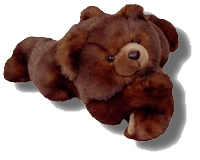Teddy Bear Information
Fun And Games
|
How to Clean A Stuffed Animal
 Cleaning a stuffed animal can be a challenge. Some stuffed animals can be thrown in the washer and others would be damaged beyond repair by throwing them in the washer. How to clean your stuffed animal depends on the nature of the soil (e.g. a spot from your child's jelly sandwich, general soil from being dragged around the playground, or dust from being neglected on the shelf for years). Cleaning a stuffed animal can be a challenge. Some stuffed animals can be thrown in the washer and others would be damaged beyond repair by throwing them in the washer. How to clean your stuffed animal depends on the nature of the soil (e.g. a spot from your child's jelly sandwich, general soil from being dragged around the playground, or dust from being neglected on the shelf for years).
 The first thing we recommend is to determine if the stuffed animal has a manufacturers tag that has care instructions or lists materials of construction. If you know who manufactured the stuffed animal, you may be able to contact them directly for help. The first thing we recommend is to determine if the stuffed animal has a manufacturers tag that has care instructions or lists materials of construction. If you know who manufactured the stuffed animal, you may be able to contact them directly for help.
 We have talked to experts and scoured the internet to find stuffed animal cleaning methods. The methods listed here may or may not work on your particular stuffed animal cleaning challenge. This information is presented as an aide in cleaning your stuffed animal and Teddybears.org can not be held responsible for the results of using any of the cleaning methods listed in this article. We have talked to experts and scoured the internet to find stuffed animal cleaning methods. The methods listed here may or may not work on your particular stuffed animal cleaning challenge. This information is presented as an aide in cleaning your stuffed animal and Teddybears.org can not be held responsible for the results of using any of the cleaning methods listed in this article.
 Before starting, you need to ask yourself some questions: Before starting, you need to ask yourself some questions:
- Does the animal have a manufacturer's tag with materials of construction or care instructions?
- What is the nature of the soil (a spot or spots, or generally dirty)?
- How important is this stuffed animal to you?
- How valuable is this stuffed animal? If it is a collector's item or a family heirloom, you may want to seek professional cleaning help.
- Is the stuffed animal made of synthetic or natural fur? Animals made of natural fur (e.g. wool, alpaca, mohair, etc.) should not be washed in a washing machine.
- What is the stuffed animal stuffed with? Without a manufacturer's tag, this may be tough to figure out. Some stuffing materials will be very tough to dry completely.
- Polyester Poly-fill. This is the most common stuffing used today. It is water and mold resistant.
- Styrofoam. A common stuffing today for "beanbag" plush toys. Styrofoam is also water and mold resistant.
- Foam rubber. You may find older stuffed animals stuffed with foam rubber. It is a firmer material than poly-fill. It is mold resistant, but over time it will break down. It is very time consuming to replace foam rubber stuffing without making your stuffed animal lumpy.
- Cotton. Not used much because poly-fill is cheaper. Cotton will mold if it gets wet. Cotton ages reasonably well, as long as it is kept dry.
- Shredded paper. Shredded paper was mostly used in cheap plush and it not used anymore. Obviously water will damage if not completely ruin paper stuffing. Mold damage is likely if the paper gets wet.
- Wood fiber. Wood fiber was a common stuffing material in the past. Wood fiber is subject to water damage and mold it will mold if it gets wet.
- Does the stuffed animal have swivel joints? Some teddy bears, for example have swivel joints in the shoulders and hips. If these joints are metal they may rust or corrode depending on you wash your animal.
- Does the stuffed animal have removable clothing or accessories? If so, you might want to remove these before proceeding. Some clothing is tacked on and can be removed after carefully snipping the thread that holds it on.
- Does the animal have any sound boxes or similar devices?
- Does the stuffed animal have any seams that are torn or look weak? You will want to repair these before proceeding with any cleaning efforts.
 OK. So hopefully now you are ready to pick a cleaning method for your stuffed animal. The cleaning methods we have found are listed in no particular order so make sure you take a look at each method before diving into your cleaning job. OK. So hopefully now you are ready to pick a cleaning method for your stuffed animal. The cleaning methods we have found are listed in no particular order so make sure you take a look at each method before diving into your cleaning job.
- If something gets spilled on your stuffed animal, do not use a cloth to wipe off the spill. Instead shake the stuffed animal vigorously so most of the spill will fly off. Then depending on what is left of the spill, press a dry towel into the wet area to soak up the remaining wetness. If some of the spill still remains, use a damp towel or sponge to dilute the remaining spot and press the dry towel into the area again. Keep doing this until the spot is gone or as gone as it is going to get.
- Use a vacuum cleaner with a brush attachment to provide a gentle cleaning and to remove loose dust and dirt.
- Instead of using a vacuum cleaner, you could put your stuffed animal on the clothes line on a windy day to remove loose dust and dirt. Don't put it in the sun, though, as this will speed fading.
- You can also use a lint roller to remove loose dirt and pet fur.
- If the animal looks clean, but just smells bad, you might try something like Fabreeze. This won't clean your stuffed animal, but it will make it more pleasant to be around.
- "Dry" clean your stuffed animal by putting it in a shopping bag with about ? cup of baking soda, baby powder, or cornstarch and shaking it. Then use your vacuum cleaner with brush attachment to clean off excess baking soda. Instead of using your vacuum cleaner, you can shake the animal or rub it with a towel to remove excess baking soda or baby powder. Note that chemical dry cleaning by your local dry cleaners is NOT recommended because of potential damage to the stuffed animal.
- Use a damp cloth without soap and wipe the stuffed animal all over. Then, depending how the fur looks, brush it our using a clean hairbrush. If the stuffed animal still looks dirty, try this method again after the animal is dry before moving on to other cleaning methods.
- If the stuffed animal is still dirty after using the above method, use a damp cloth with soap (for example a Woolite type cleaner) and wipe the stuffed animal all over. Some argue that the use of soap is not a good idea and will leave residue. Then use a clean wet cloth to remove the soap residue. Then, depending how the fur looks, brush it our using a clean hairbrush. Brush very carefully to avoid pulling out fur that can't be replaces.
- Wash the stuffed animal in the washing machine after putting it in a pillow case or cloth bag that can be closed. Don't put the animal in a "delicates" mesh bag, since the reason for using a bag is to protect the animals fur. Use a gentle cycle and cold water wash and rinse, and just a little detergent. Woolite, Oxyclean or a similar type cleaner has been used successfully by some people. As you can imagine, your stuffed animal will get very wet and the stuffing will need to be dried completely to avoid possible mold.
- To dry a stuffed animal, you can put it in the dryer, dry it outside, or use a blow dryer. Be careful to use low heat to avoid damage to the fur. Also, not that air drying the animal outside may not work depending on how wet the animal is to start and how dry our climate is.
- A spray-on cleaner, e.g. Simple Green, may work to remove spots and provide a general surface cleaning. Just spray it on and use a damp washcloth or sponge to wipe it clean. You might want to try a very small area first to make sure the cleaner doesn't fade or damage the fur.
- This method will take a lot more time and effort, but depending on your animal and what you know about it, it may be worth the effort, especially if you do not know what your animal has for stuffing. Find a seam in the body and carefully split open a section long enough to be able to reach in and remove all of the stuffing. Then wash the skin using your selected method. Depending on the condition of the stuffing, you can either replace it with new batting or put in the old stuffing back in.
- There is a cleaning product called Teddy Bear Bath - Plush Toy Stain Remover from Gund. We have tried this product and it has worked for the limited stains we have tried it on. A 12 ounce bottle the costs about $6.00 at Freebears.com (http://www.freebears.com). Try searching on Google for stores that sell this item. We are planning to order some and try it. Then we will update this item.
- Steam cleaning may be an option, but unless you already own a steam cleaner designed for garments, this will be a fairly expensive option.
 We hope this helps you decide how to clean your favorite stuffed animal. You might want to contact one of the stuffed animal repair companies listed on our website for more information on professional cleaning if you have an antique animal or if you still have questions. We hope this helps you decide how to clean your favorite stuffed animal. You might want to contact one of the stuffed animal repair companies listed on our website for more information on professional cleaning if you have an antique animal or if you still have questions.

 Visit our supporters at https://nodepositpromocodes.com. Visit our supporters at https://nodepositpromocodes.com.
|
